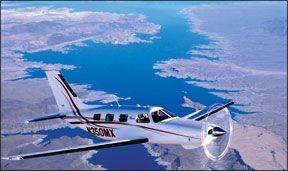The Piper Matrix is un-American. The rules clearly state that automobiles and airplanes are to get bigger, heavier, more complicated and less efficient as the production years pass. Go look it up. Cars outgrow garages and airplanes lose useful load. Simplifying an American vehicle is not acceptable. Increasing an airplanes efficiency and useful load is probably a federal offense. The offender-Piper-has created a very good airplane thats selling as fast as it can be built. Piper took a risk in creating a simplified, unpressurized version of its decades-old Malibu/Mirage. To the extent market history exists for such a decision, its lousy. In 1980, Cessna produced an unpressurized version of the Model 340A, the 335, which did poorly and was dropped after only one year of production. 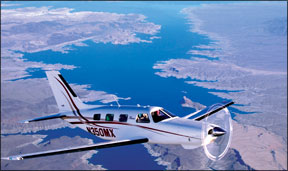
In the new Matrix, Piper didnt make Cessnas mistake of reducing performance of an existing model and it kept the same 350-HP Lycoming TIO-540-AE2A that the Mirage has. Piper also spent money on market surveys to assess demand for the proposed airplane as we’ll as the right price point. Despite the current economic downturn, it appears the decision was a winner.
To create the Matrix, Piper cut both weight and price. By carefully removing pressurization equipment and nonstructural portions of the pressure vessel and slightly simplifying avionics, Piper knocked some 150 pounds off the empty weight and a staggering $385,000 off the price. A typically equipped Matrix invoices for about $757,000, with the only big ticket option being known icing approval, which costs $55,000 and knocks 4 knots off the cruise speed. The price means that the Saratoga HP, which is only marginally less expensive and has gotten so heavy as to essentially make it a two-place airplane with full fuel, will go out of production.
Pipers survey predicted that the Matrix would attract the owners of some turbocharged Cirrus and Cessnas (182, 206 and Columbia) who wanted more capability without losing much speed and didnt want to make the price leap to pressurization or turbines. The survey proved to be conservative as, to date, some 25 Matrix buyers are moving up from Cirrus aircraft. Taking a leaf from Cessnas old marketing book, Piper is hoping to bring those buyers into the fold and eventually move them up from the Matrix to the Meridian and its own jet, which just made its first flight. Were impressed. Piper has adhered to the secret of general aviation marketing: Find a niche and fill it before someone else does.
Similar, But Different
On the ramp, the only giveaway that the airplane youre facing is a Matrix rather than a Mirage is that it has slightly bigger windows. Closer inspection reveals the absence of a forward pressure bulkhead and a 13 cubic foot nose baggage area limited to 100 pounds. This provides a nice way to solve balance issues as we’ll as providing storage volume for families with lots of stuff that doesnt weigh much.
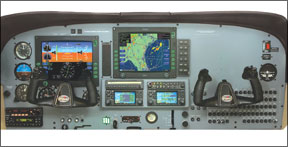
The two wing tanks hold a total of 120 usable gallons, with the fuel selector lever hidden behind the control yoke. We were surprised not to find some positive lockout from the left to the off position, making an inadvertent fuel shutoff possible.
The landing gear is hydraulic, with free fall backup. Its such a well-thought-out system that we would be surprised if a pilot is ever unable to lower the gear. Flaps are three-position and electrically operated. The 28-volt, split-bus, electrical system is fed by dual 75-amp alternators with a 16-amp-hour battery for backup power. There’s a vacuum pump only if the airplane has deicing boots; no flight instruments use vacuum.
Fit and Finish
Fit and finish of the airplane, both inside and out, are excellent and this shows on the clamshell airstair door, which is solid and attractive and should hold up we’ll in service. Ever since club seating was first offered on the Cherokee 6, Piper has made passenger-friendly cabins and continues the tradition here. The interior alone will sell the Matrix to a lot of non-flying spouses. All four of the club seating chairs recline and the rear seats individually fold forward to reach the rear baggage area.
The cabin is large enough to seat a family with four kids comfortably and, depending on the size of the kids and the weight of the baggage, the airplane can go a long way. While there isn’t a potty, there is a relief tube. The only complaint we had about the cabin is the lack of head and legroom for the pilot.
From a crashworthiness standpoint, all seats have three-point harnesses and the fuel tanks are we’ll out in the wings. We don’t much like the lack of flail space in the cockpit and would prefer four- or five-point harnesses up front. Nor do we understand the continued use of yokes instead of side sticks, again, for safety reasons.
Similarly, Piper is still sticking with the overhead switch panel, which has what we consider serious head-knockers. including metal bars over the starter and mag switches. Further, overhead switches are just hard to see and read and there’s plenty of panel space to mount them there.
Piper has stuck with the Avidyne Entegra for the Matrix-a good choice. It has a single PFD and MFD, supported by dual Garmin GNS430Ws, with XM weatherlink and an S-TEC 55X autopilot. This is a small step down from the Mirage, but gives up no significant functionality. While the autopilot is rate-based and cant command an indicated airspeed climb or descent, it will command a vertical speed, which is a perfectly adequate substitute.
Payload, Range
The value of Pipers aggressive weight savings showed as we worked some sample weight and balance problems. Even at max cruise, where the burn rate is on the order of 20 GPH, full fuel
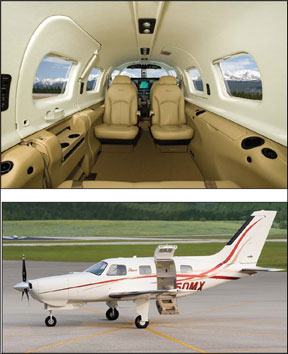
translates to five-plus hours to dry tanks. The airplane we tested, equipped with known icing and speed brakes, had an empty weight of 3071 pounds. Max ramp weight is 4358 pounds, giving the tested airplane a useful load of 1287 pounds, or 134 pounds less than in Pipers advertising literature.
With all 720 pounds of fuel in the tanks, 567 pounds of people and stuff can go into the cabin. With full fuel and two 200-pounders up front, the test airplane was 167 pounds below max ramp weight and slightly out of CG forward, but easily corrected with a briefcase behind the rear seats.
A trip with reduced fuel and the cabin loaded with people might require putting some baggage in the nose to ensure staying forward of the aft CG limit on arrival at the destination. We would like to see Piper provide an electronic weight-and-balance calculator that can be downloaded into a Blackberry or similar device, as has been done by Pilatus.
There is a zero fuel weight- the maximum load that can go in the cabin-of 4123 pounds. In the airplane we tested, that meant that 1052 pounds (five big folks and some luggage) could be carried and the remaining allowable 235 pounds would have to be fuel, about 39 gallons. Thats enough fuel for a two-hour VFR trip at long-range cruise.
However, and inexplicably, it would mean running the tanks dry before landing as the max landing weight is precisely the same as the zero fuel weight, making the real-world zero fuel weight something less if one wants to touch down with the engine running. We should point out that Piper engineers apparently believe that no one weighing over 170 pounds will be flying in the Matrix as the graphs for passenger weights don’t go above 340 pounds per row of seats, a strange shortcoming in the POH. The lines in the graphs should be longer to make them usable.
We found the cabin load versus fuel tradeoff to require less compromise in the Matrix than in many other piston airplanes. Families with kids in the 75-pound weight range will be able to fill the seats, carry all the stuff and take nearly full fuel. Avoiding oxygen use by flying at 10,000 feet, full-fuel VFR range at high-speed cruise, with reserve, is 960 miles while at 185 KTAS. Long-range cruise gives 1343 miles at 130 knots. Piper doesnt give percentage power settings, but rather “high-speed, normal, economy and long-range” cruise power settings.
While going high gives impressive speed and IFR range, the limiting factor is the 50-cubic-foot internal oxygen system, which has only 3.1 hours for three people at FL200. The time above 10,000 feet on the long-range cruise power flight would be about 7 hours. With four 200-pounders and 100 pounds of baggage, NBAA IFR range is about 350 miles at high-speed cruise and over 500 miles at long-range cruise at 10,000 feet.
Flying It
The pressurization in the Mirage has much more hot bleed air to cool, but the air conditioning in the Matrix is the same system. As a result, it has a great air conditioner that cools the cabin quickly. Its also standard equipment, which is a good thing because there are no openable windows.
Takeoff is with flaps either up or at 10 degrees-20 degrees for short field. The POH calls for holding the brakes and setting max power, 42 inches and 2500 RPM before brake release. Exceeding 42 inches is annunciated in red, which is a little disconcerting as a few tenths of an inch is certainly not a critical item and is in the range of error of the automatic turbo control system. Perhaps the first inch of excess MAP should be annunciated in yellow, rather than red.
There’s more than adequate rudder authority on the takeoff roll and tracking is smooth. The airplane flies off at 80 to 85 KIAS. As with other heavy, high- performance singles, unless youre making
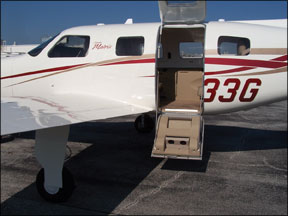
an obstacle clearance takeoff, the climb angle is initially shallow as the airplane continues to accelerate. Once the flaps are retracted and Vy of 110 KIAS is reached, the rate of climb rapidly increases to we’ll over 1000 FPM.
Normal climb is with full power (which is also maximum continuous power) and 125 KIAS for cooling and visibility over the nose.
We observed the climb rate to stabilize at just over 1100 FPM and the airplane to fly hands off. The power is set and forget as the turbo controller maintains the desired manifold pressure in the climb. Fuel flow remained at 42 GPH. During our climb the hottest CHT was 404 degrees, an indication that without having to pump up a cabin , the engine wasnt working as hard. Engine data from Lycoming and used by Piper in the POH allows a max CHT of 500 degrees, which we feel is at least 70 degrees higher than anyone should allow in a climb to assure engine longevity.
Piper publishes climb data for a max continuous power climb at 110 and 125 KIAS and also for a reduced power (35 inches at 125 KIAS) climb. Why anyone would operate the airplane at reduced power eludes us. It takes longer and requires more fuel to climb to any altitude at reduced power.
During climb, we found the S-TEC autopilot accurately held selected rates of climb, which were easily programmed through the integrated Avidyne system. At 16,500 feet, we observed 196 KTAS on 21 GPH. As has been our experience with current production Pipers, speed was exactly on the book while fuel flow was one GPH higher than book. CHTs stabilized with the hottest at 380 degrees, which we consider to be the maximum acceptable for cruise for any piston airplane. Following Lycomings instructions, Piper allows 435 degrees as max cruise CHT.
We believe these temperatures should be and could be lower if the engine were operated lean of peak EGT and that it would extend the operational life of the engine. As an OEM, Piper cant publish
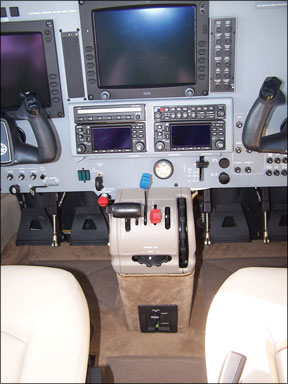
lean-of-peak operational data in the POH because Lycoming wont authorize it. We believe this hamstrings Piper; the company is clearly sophisticated enough to recognize the value of lean-of-peak operations. We continue to be baffled by Lycomings resistance to this well-established trend.
Handling
Maneuvering flight revealed a fairly steep stick-force-per-G gradient, which, in our opinion, means that it would take a hamfisted pilot to inadvertently stall the Matrix. It also meant steep turns required some effort and trim to help hold the nose at the desired attitude. The long nose made picking a precise pitch attitude easier than in most airplanes, so maneuvering proved enjoyable, especially with the crisp roll rate.
Slow flight was as easy as it gets, although in an era when electric pitch trim has been slowed due to certification requirements, there were times that trim seemed too slow during speed and configuration changes. Nevertheless, the Matrix is easily trimmed to fly hands off only a few knots above stall speed.
Configuration changes, gear and flap extension and retraction, created only minor pitch changes and all controls were fully effective through the stall. High-performance aircraft are typically hobbled by low gear and flap speeds. Not the Matrix. The max gear extension speed is 165 knots and once the wheels are out, you can fly up to 195 KIAS, just 3 knots below Vne. Speed brakes are an option, but the wheels can do the trick. The first notch of flaps can go out at 165 knots, too.
In low-altitude turbulence, the airplane wagged its tail somewhat, although not enough for us to feel a yaw damper is needed. However, we did hit our head on the ceiling enough to wish for more headroom. (The reviewing pilot is 6-feet-4 inches tall.)
Flying the traffic pattern was a pleasure. The low nose position and seating position near the leading edge of the wing makes for good visibility, backed up by having a traffic alert system tied in with the Avidyne. Ten degrees of flap on downwind and about 120 knots allowed smoothly fitting in with traffic. Twenty degrees on base, with full flaps and about 80 knots on final, with power to idle prior to the flare lead to positively controlled touchdowns at near stall speed and plenty of control authority for crosswinds.
Conclusion
Although we werent so sure when Piper announced the Matrix, we think the airplane is a winner. we’ll go out on a limb and opine that if Piper can drag Lycoming kicking and screaming into the 21st century and publish lean-of-peak operating data to reduce engine operating temperatures and cut fuel burn, the airplane will make the leap from good to great. Perhaps it will do just that with the new TEO-540-A described on page 24 of this issue.
Rick Durden is an Aviation Consumer contributing editor. He lives in Denver.

